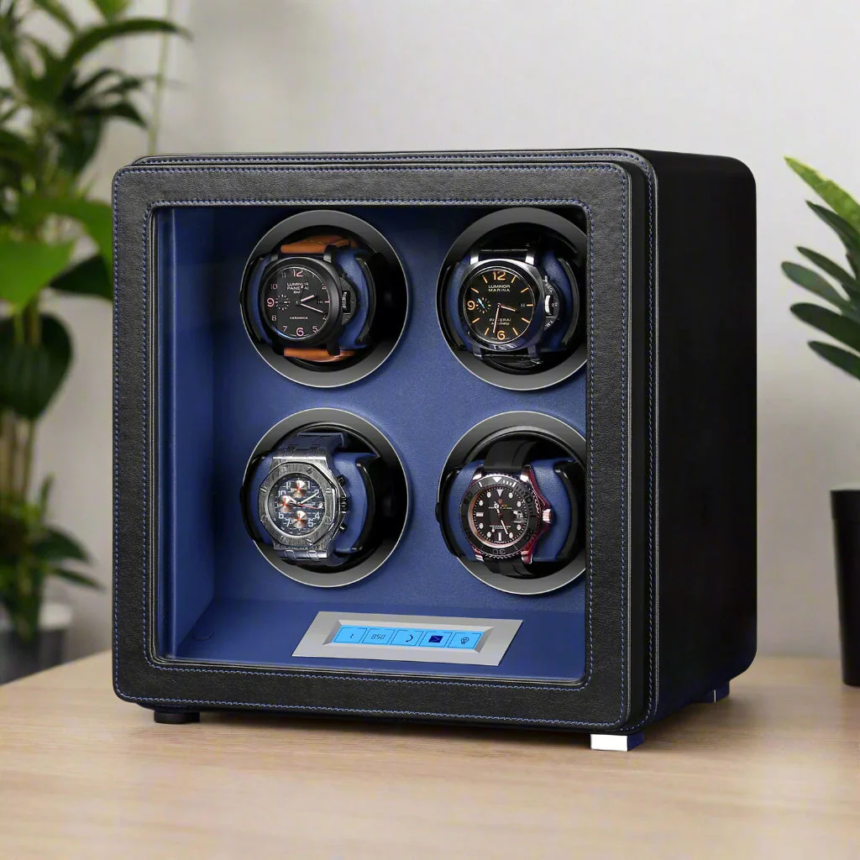In the world of luxury and precision timepieces, automatic watches are treasured for their intricate craftsmanship and self-sustaining movement. However, when these watches aren’t worn regularly, their mechanical energy can dwindle, affecting performance and longevity. This is where an automatic wrist watch winder comes into play. In this comprehensive guide, we’ll explore every facet of automatic watch winders—from how they work to the benefits they offer and what to consider when selecting one. Whether you’re a seasoned collector or a new enthusiast, this article will provide the insights you need to make an informed decision.
- Introduction
- Understanding Automatic Watches
- What is an Automatic Wrist Watch Winder?
- Key Benefits of Using an Automatic Wrist Watch Winder
- Consistent Timekeeping
- Protection of Mechanical Components
- Convenience and Readiness
- Extended Longevity
- Enhanced Collection Display
- Factors to Consider When Choosing a Watch Winder
- Maintaining and Caring for Your Watch Winder
- Practical Tips and Best Practices
- Follow Manufacturer Guidelines
- Avoid Over-Rotation
- Monitor Watch Performance
- Diversify Winding Techniques
- Invest in Quality
- In-Depth Look: The Impact of Consistent Winding on Mechanical Watches
- Enhancing Lubrication Distribution
- Preventing Component Settling
- Optimizing Energy Storage
- Reducing the Need for Manual Winding
- A Closer Look at Design Considerations
- Advanced Features in Modern Watch Winders
- Economic Considerations: Investing in Your Watch Winder
- Real-Life Applications and Use Cases
- Conclusion
- FAQs
Introduction
Automatic watches are not just tools to tell time—they are a symbol of art, tradition, and mechanical ingenuity. While these watches derive energy from the motion of the wearer’s wrist, there are instances when they may not be worn for an extended period. When left idle, the absence of motion can lead to the gradual depletion of the watch’s stored energy. An automatic wrist watch winder solves this issue by simulating the natural movements of the wrist, ensuring that your prized timepiece remains wound, accurate, and ready to wear at all times.
In this article, we’ll delve into the mechanics behind both automatic watches and their winders, detail the benefits, and offer practical guidance on selecting and maintaining the right watch winder for your collection.
Understanding Automatic Watches
The Mechanics Behind Automatic Watches
Automatic watches, also known as self-winding watches, use the kinetic energy generated by the movement of the wearer to wind the mainspring, which powers the watch. Inside these watches, a rotor swings with each movement, converting the motion into stored energy. This energy is then gradually released to power the watch. The beauty of automatic watches lies in their mechanical complexity and the fact that they do not require a battery.
Key components of an automatic watch include:
- Rotor: A weighted semicircular disc that oscillates with movement.
- Mainspring: A coiled spring that stores energy.
- Gear Train: A series of gears that transfer the stored energy to regulate the movement of the hands.
- Escapement: A mechanism that ensures the controlled release of energy to maintain consistent timekeeping.
The Need for Consistent Movement
When an automatic watch is not in regular use, its power reserve eventually depletes. This can result in:
- Timekeeping Inaccuracy: Without consistent winding, the watch may start to lose or gain time.
- Mechanical Strain: Repeated winding from manual resets might stress the movement over time.
- Lubrication Issues: Periods of inactivity can lead to the thickening or settling of lubricants, affecting precision.
An automatic watch winder replicates the natural motion needed to keep these watches running smoothly, thereby extending their longevity and ensuring they are always ready for use.
What is an Automatic Wrist Watch Winder?
An automatic wrist watch winder is a device specifically designed to keep automatic watches running when they aren’t being worn. By simulating the natural movements of the wrist, a watch winder ensures that the watch’s rotor continues to function, keeping the mainspring wound and the timepiece in optimal condition.
How It Works
Watch winders operate by gently rotating the watch in one or more directions. The rotation mimics the subtle movements of a human wrist, which allows the rotor inside the watch to wind the mainspring. Key features often found in these devices include:
- Multiple Rotation Settings: Options to adjust the speed, direction, and duration of the rotation.
- Quiet Operation: Advanced designs incorporate noise reduction features so the device can operate discreetly, even in a quiet environment.
- Power Options: Many winders offer dual power options, including battery and AC power, to ensure continuous operation.
- Cushioned Interiors: To protect the watch from scratches and impacts, winders are usually lined with soft, padded materials.
Types of Automatic Watch Winders
Watch winders vary in terms of complexity, capacity, and additional features. Here are some of the common types:
Single-Watch Winders
Ideal for collectors who own only one or two automatic watches, these compact devices are designed to accommodate a single timepiece. They are often praised for their simplicity and ease of use.
Multi-Watch Winders
For collectors with a larger assortment of automatic watches, multi-watch winders provide the convenience of winding several watches simultaneously. These models come with compartments or slots to ensure each watch is securely held and properly rotated.
Programmable Winders
These winders allow for precise control over the winding process. With programmable settings, users can customize the rotation direction, number of rotations per day, and the duration of each cycle to suit the specific requirements of their watch.
Luxury Winders
While maintaining a simple yet effective design, luxury winders often feature high-quality materials, advanced movement technology, and sophisticated aesthetics that complement premium watch collections.
Below is a table summarizing the differences between these types:
| Type | Capacity | Key Features | Ideal For |
| Single-Watch Winders | 1 watch | Compact, simple rotation settings | Casual collectors, single watch owners |
| Multi-Watch Winders | 2 or more watches | Multiple compartments, synchronized winding cycles | Large collections, enthusiasts |
| Programmable Winders | Varies | Customizable settings, multiple rotation configurations | Precision users, varied watch needs |
| Luxury Winders | Varies | High-end materials, advanced technology, aesthetic design | Premium collections, connoisseurs |
Key Benefits of Using an Automatic Wrist Watch Winder
Investing in an automatic wrist watch winder offers several advantages that go beyond merely keeping a watch running. Here are some of the most significant benefits:
Consistent Timekeeping
One of the primary functions of a watch winder is to ensure that your automatic watch remains wound and keeps accurate time. This is particularly beneficial if you own multiple watches and rotate them frequently, as it eliminates the need to manually reset the time each time you put on your watch.
Protection of Mechanical Components
Mechanical watches are delicate instruments that require regular movement to maintain their internal lubrication and overall function. A watch winder helps preserve the integrity of the movement by reducing the strain caused by frequent manual winding, ensuring that the watch operates smoothly over time.
Convenience and Readiness
For those who rely on their automatic watches daily, a watch winder ensures that your timepiece is always ready for immediate use. This convenience is especially important for busy professionals and collectors who appreciate the assurance of never having to reset their watch.
Extended Longevity
By maintaining a consistent winding routine, the wear and tear on the watch’s movement are minimized. This practice can extend the life of your timepiece, preserving its value and functionality for years to come.
Enhanced Collection Display
Many watch winders are designed with aesthetics in mind, making them an attractive addition to any display case. They not only serve a functional purpose but also enhance the visual appeal of your watch collection. The elegant design and smooth operation of a watch winder can be a point of conversation and admiration among peers.
Factors to Consider When Choosing a Watch Winder
Selecting the right automatic wristwatch winder requires careful consideration of several factors. This section breaks down the most important aspects to help you make an informed decision.
Motor Type and Rotation Settings
Motor Types
- Synchronous Motors: These motors are known for their consistent performance. They offer precise control over the rotation speed and are less likely to experience fluctuations that could affect the winding process.
- Stepper Motors: Stepper motors provide excellent control over the positioning and rotation of the watch. They are often used in programmable winders to deliver accurate winding cycles.
Rotation Settings
An essential feature of any watch winder is the ability to adjust rotation settings. Key factors include:
- Rotation Direction: Some watches require a specific rotation direction to wind properly. Many winders offer both clockwise and counterclockwise options.
- Number of Rotations Per Day (RPD): Different watches have varied winding requirements. A good winder will allow you to set the exact number of rotations per day to match the watch’s specifications.
- Intermittent Rotation: Instead of continuous rotation, some winders use intervals of rotation and pause. This mimics the natural movement of the wrist more accurately and prevents over-winding.
Materials and Design
Build Quality
The durability of a watch winder is largely dependent on the quality of its materials. Look for winders constructed with high-grade plastics, metals, or wood that not only offer longevity but also add a touch of elegance to your display.
Interior Lining
A padded, non-abrasive interior is crucial to prevent scratches and other damage to your watches. Soft fabrics, such as velvet or microfiber, are commonly used to ensure that your timepieces are protected during the winding process.
Aesthetic Considerations
Since many watch winders are also used as display pieces, the design should complement your overall collection. Whether you prefer a minimalist look or a more ornate style, choose a design that resonates with your personal taste and fits seamlessly into your décor.
Size and Capacity
Single vs. Multiple Watch Holders
Decide whether you need a winder for one watch or for multiple timepieces. While single-watch winders are typically more compact and straightforward, multi-watch winders offer the convenience of handling several watches simultaneously.
Space Considerations
Consider the physical space available in your home or office. Winders come in various sizes—from small desktop units to larger cabinet-style designs. Ensure that the model you choose fits well in your intended display area.
Noise Level
A watch winder should operate quietly, particularly if you plan to keep it in a bedroom or office environment. Look for models that emphasize silent or near-silent operation, as excessive noise can be a distraction.
Maintaining and Caring for Your Watch Winder
Proper maintenance of your automatic wristwatch winder not only prolongs its lifespan but also ensures that it continues to function optimally. Here are some maintenance tips:
Regular Cleaning
Dust and debris can accumulate on the exterior and interior of your watch winder. Regularly clean the surface with a soft, lint-free cloth. For the interior, gently wipe down the lining material to maintain its softness and effectiveness.
Check the Mechanism
Periodically inspect the rotation mechanism for any signs of wear or malfunction. If the winder begins to make unusual noises or the movement seems erratic, it might be time to have it serviced by a professional.
Power Source Maintenance
If your winder operates on batteries, replace them according to the manufacturer’s recommendations. For AC-powered models, ensure that the power cable and adapter are in good condition to avoid any disruptions in operation.
Storage
When not in use, store your watch winder in a clean, dry place away from extreme temperatures and humidity. Proper storage helps prevent any potential damage to the delicate mechanical components of the winder.
Firmware or Software Updates
Some advanced, programmable watch winders may have firmware or software that controls the winding cycle. Keep an eye out for any available updates from the manufacturer to ensure that your device operates with the latest settings and features.
Practical Tips and Best Practices
To maximize the benefits of your automatic wrist watch winder and ensure the longevity of both the device and your watches, consider the following best practices:
Follow Manufacturer Guidelines
Always refer to the manufacturer’s instructions for both your watch and the winder. Each model may have specific requirements or recommendations that can help optimize performance.
Avoid Over-Rotation
Even though many winders offer adjustable rotation settings, it is essential to match these settings with your watch’s specifications. Over-rotation can potentially strain the watch movement over time.
Monitor Watch Performance
Keep an eye on how your watch performs after extended periods in the winder. If you notice any irregularities in timekeeping, it might be necessary to adjust the settings or give the watch a break from constant rotation.
Diversify Winding Techniques
If you have multiple automatic watches, consider rotating their usage. Even with a reliable winder, it’s a good idea to allow each watch some downtime to ensure that the mechanical parts are not subject to continuous motion stress.
Invest in Quality
While it might be tempting to opt for a lower-cost model, investing in a high-quality automatic wristwatch winder can save you money and preserve your collection in the long run. Quality devices are built to last and offer better precision, which directly contributes to the overall health of your watch.
In-Depth Look: The Impact of Consistent Winding on Mechanical Watches
Mechanical watches are marvels of engineering, and their performance is deeply intertwined with the regularity of motion. Here’s an in-depth look at how consistent winding impacts your watch:
Enhancing Lubrication Distribution
Inside an automatic watch, lubricants ensure that the moving parts operate with minimal friction. When the watch is in regular motion, these lubricants are evenly distributed, preventing localized wear and tear. A watch winder replicates this movement, ensuring that every gear and pivot receives the necessary lubrication.
Preventing Component Settling
Extended periods of inactivity can lead to the settling of components, which might affect the watch’s precision. Consistent movement provided by a watch winder keeps the components in constant motion, thereby preventing the potential for mechanical issues that could arise from prolonged stillness.
Optimizing Energy Storage
The mainspring in an automatic watch stores energy generated by the rotor. A regularly wound watch maintains an optimal level of tension in the mainspring, which in turn ensures that the energy release is steady and controlled. This consistent energy storage is crucial for maintaining accurate timekeeping and the overall reliability of the watch.
Reducing the Need for Manual Winding
Manual winding, while effective, can sometimes lead to uneven stress on the movement if not done correctly. By relying on a watch winder, you minimize the risk of over-winding or inconsistent winding, thereby reducing the potential for mechanical wear.
A Closer Look at Design Considerations
When choosing an automatic wrist watch winder, design plays a pivotal role in both functionality and aesthetic appeal. Below, we break down the design considerations:
Ergonomic Design
- User Interface: Look for models that are easy to set up and program. A straightforward interface allows you to adjust settings without hassle.
- Visibility: A clear display or indicators that show the current rotation settings and operational status can enhance usability.
- Portability: While many winders are designed to be stationary, some models offer portability features, allowing you to move them between different locations without compromising performance.
Aesthetic Appeal
- Material Quality: The use of premium materials like genuine wood veneers, brushed metal, or high-quality plastics not only protects your watches but also complements the décor of any room.
- Finish and Detailing: Simple, elegant designs with clean lines are often preferred by collectors. The winder should act as a complement to your collection, not an eyesore.
- Lighting Options: Some high-end models include subtle LED lighting that not only enhances the display of your watches but also adds a touch of sophistication.
Advanced Features in Modern Watch Winders
The evolution of technology has also touched the realm of automatic watch winders. Today’s models often incorporate advanced features designed to optimize performance and user convenience:
Programmable Controls
Modern watch winders offer programmable options that allow you to tailor the winding cycle to your watch’s specific requirements. This includes setting the number of rotations per day, choosing the rotation direction, and even programming rest periods to prevent over-winding.
Dual Power Options
To ensure uninterrupted operation, many winders offer both battery and AC power options. This dual-power capability provides the flexibility to use the winder in various settings, whether at home, in the office, or during travel.
Smart Connectivity
Some of the latest watch winders come equipped with smart connectivity features, allowing you to control and monitor the device remotely via a mobile app. These features can include scheduling, notifications, and even diagnostics to alert you if the winder requires maintenance.
Silent Operation Technology
Noise can be a major concern, especially if the winder is kept in a quiet environment like a bedroom or office. Advances in motor design and insulation materials have led to the development of near-silent watch winders that do not disrupt daily life.
Economic Considerations: Investing in Your Watch Winder
When evaluating an automatic wrist watch winder, it is important to weigh the costs against the long-term benefits. Here are some economic factors to consider:
Initial Investment vs. Long-Term Savings
While a high-quality watch winder may come with a higher upfront cost, it is important to consider the long-term savings. Regular use of a winder can extend the life of your automatic watch, reducing the need for frequent servicing and repairs.
Energy Consumption
Modern watch winders are designed to be energy-efficient. Whether operating on batteries or AC power, look for models that balance performance with low energy consumption. This not only reduces your carbon footprint but also minimizes ongoing operational costs.
Resale Value of Your Collection
A well-maintained automatic watch is likely to retain its value better than one that has been neglected. By investing in a reliable watch winder, you are indirectly contributing to the preservation of your collection’s resale value, should you ever decide to part with any pieces.
Real-Life Applications and Use Cases
Automatic wrist watch winders are not just a luxury accessory; they serve a practical purpose for a diverse range of users. Here are some real-life scenarios where a watch winder can be especially beneficial:
Daily Wearers
For individuals who rotate multiple watches on a daily basis, a watch winder ensures that each timepiece is consistently ready for wear. This is particularly useful for professionals who prefer a different watch for various occasions—be it a formal meeting, casual outing, or sporty event.
Collectors and Enthusiasts
Watch collectors often invest significant time and resources into acquiring and maintaining their collections. A watch winder not only preserves the mechanical integrity of these watches but also serves as an attractive display piece, showcasing the collection in a curated and organized manner.
Gift for Watch Aficionados
An automatic wrist watch winder makes an excellent gift for anyone passionate about mechanical watches. It demonstrates both a commitment to quality and an understanding of the intricate care that luxury timepieces require.
Preservation of Heirloom Pieces
For those who inherit or own vintage mechanical watches, a watch winder can be a critical tool in ensuring that these heirlooms remain in prime condition. The gentle, continuous movement helps to prevent deterioration of the delicate mechanisms that have been passed down through generations.
Conclusion
An automatic wrist watch winder is more than just an accessory; it is an essential tool for anyone who owns automatic watches. By providing consistent movement, it ensures that your mechanical timepieces remain accurate, well-lubricated, and ready to wear. Whether you are a daily wearer, a serious collector, or someone looking to protect a valuable heirloom, a watch winder offers both practical benefits and aesthetic appeal.
From understanding the inner workings of automatic watches to exploring the advanced features of modern winders, this guide has aimed to offer a comprehensive overview of what you need to know. By carefully considering factors such as motor type, rotation settings, materials, and design, you can select a watch winder that not only meets your technical requirements but also complements your lifestyle and collection.
Investing in a quality automatic wrist watch winder is an investment in the longevity and performance of your cherished timepieces. As technology continues to evolve, these devices are set to become even more sophisticated, offering enhanced customization, eco-friendly designs, and smart connectivity. In a world where time is of the essence, ensuring your watch remains as reliable as the moment it was crafted is a testament to the enduring artistry of mechanical watchmaking.
FAQs
1: What is the primary function of an automatic wrist watch winder?
An automatic wrist watch winder is designed to simulate the natural movement of the wrist, ensuring that automatic watches remain wound and operational even when not being worn. This prevents timekeeping issues and maintains the watch’s mechanical integrity.
2: Do all automatic watches require a winder?
Not necessarily. Some automatic watches have long power reserves and can run for up to 48 hours or more on a full wind. However, if you own multiple watches or plan to store your timepieces for an extended period, a winder is a practical solution.
3: How often should I use a watch winder?
The frequency largely depends on the watch’s specifications and your personal routine. Generally, if a watch is left unworn for several days, using a winder helps maintain its performance. Always consult your watch’s manual for specific recommendations.
4: Can a watch winder cause damage to my watch?
When used correctly and set according to the watch’s requirements, a watch winder should not cause any harm. However, incorrect settings—such as excessive rotations—can strain the watch movement over time.
5:Is noise a common issue with watch winders?
High-quality watch winders are designed to operate quietly. If you notice loud operational noise, it may be an indication that the device is either of lower quality or in need of maintenance.
6: How do I clean and maintain my watch winder?
Regularly dust the exterior with a soft cloth, inspect the internal mechanism periodically, and follow any specific guidelines provided by the manufacturer regarding power source maintenance and storage.














